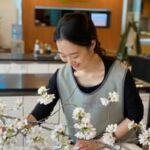In peak summer, Korean rice tables fill with vibrant greens that cool and nourish the body. One of the most beloved ways to enjoy the season? It’s Ssam (쌈), or Korean vegetable rice wraps, paired with a rich, umami-packed gang-doenjang (강된장), a thickened soybean paste stew.
This dish is a quintessential part of Korean home cooking and makes the most of summer’s abundance of leafy vegetables. Fold a spoonful of warm rice and savory sauce into tender cabbage or squash leaves, and take a single, satisfying bite. It’s a mouthful of summery comfort!
Watch it on Youtube:

What is Gang-doenjang?
Gang-doenjang literally means “thickened soybean paste” – it’s a heartier, more condensed cousin of doenjang-jjigae (soybean paste stew). These two dishes are among the most commonly enjoyed ways to cook with doenjang (Korean fermented soybean paste). If you’re curious about how it’s made and used in traditional Korean cooking, take a look at my Guide to Korean Jang. Made by simmering doenjang with vegetables, tofu, and sometimes mushrooms or seafood, it’s reduced until spoonable and deeply flavorful.
In this vegan version, we use dried pyogo mushrooms (shiitake), summer vegetables, and tofu to create a savory sauce that perfectly complements the freshness of steamed or blanched greens. It’s also a great alternative to ssamjang (쌈장), the usual go-to sauce for wraps.
Best Greens for Ssam
The beauty of ssam lies in its flexibility. You can use almost any leafy green that can fold around rice:
- Cone cabbage / pointed cabbage (spitskool or chou pointu)
- Napa cabbage
- Romaine or red leaf lettuce
- Squash leaves
- Chard or beetroot leaves
💡 Pro tip: In Europe, look for pointed cabbage or summer greens at farmers markets. They’re ideal for wrapping and taste tender and mild when blanched.
Here’s my summer favorite, squash leaves! If you have squash plants in your garden, did you know the leaves are actually edible? They make amazing ssam!


How to Prepare Leafy Greens
Not all leaves are created equal. Some, like chard or squash leaves, have tougher stems or fibrous strands. Here’s how to prep them right:

Removing Fibers🌱
For greens with thick stems (like squash or chard):
- Flip the leaf backside up
- Break off the tip of the stem
- Gently pull to peel away tough fibers along the stem
Cooking Times🔥

- Cabbage & squash leaves: Blanch for 2–3 minutes until tender. Cool immediately in cold water.
- Chard/beet greens: Submerge stems first in boiling water (30 sec), then the rest of the leaf (30 sec). Cool immediately in cold water
How to Make a Ssam Wrap


Once your greens and gang-doenjang are ready:
- Lay a leaf in your palm
- Add a spoonful of warm rice
- Top with a small spoon of gang-doenjang
- Fold and pop the whole thing in your mouth!
🥢 Don’t bite in! Korean etiquette says: eat it whole for full flavor and fewer spills.
Gang-doenjang Recipe (Vegan): Step-by-Step
Ingredients (Serves 2):
- 2 dried shiitake mushrooms
- ½ cup diced onion
- ½ cup diced zucchini
- ¼ cup sliced green onion
- 1 hot green chili (optional)
- 200g tofu (about 7 oz)
- 1 tsp vegetable oil
- 2½ tbsp doenjang (Korean soybean paste; use 2 tbsp if using homemade)
- ½ tbsp gochugaru (Korean red chili powder)
- 1 cup water (including mushroom soaking water)
Instructions:
- Soak dried shiitake mushrooms in warm water (10–20 minutes). Reserve soaking water.

- Chop mushrooms and all vegetables into bite-sized pieces. Mash tofu.


- Heat oil in a pot over medium heat. Add onion and mushroom, stir-fry until onion is translucent.

- Add doenjang and stir for 1 minute until fragrant.

- Pour in soaking water and bring to a boil. Add zucchini, green onion, and chili (if using).

- Add tofu and simmer until most of the liquid evaporates and it becomes thick and spoonable.

- Stir in gochugaru and turn off heat.

Ingredients for Serving (Ssam)
- ¼ head of cone cabbage (or napa, romaine, etc.)
- 5–6 chard, beetroot, or squash leaves (optional)
- 2 bowls of freshly steamed rice
Prepare leaves as above (blanch if needed), plate with rice and gang-doenjang. Assemble wraps by hand and enjoy immediately!

Seasonality & Sustainability
Ssam is one of the most delightful ways to celebrate leafy greens in summer. Cooks in Korea often reach for squash leaves, beetroot greens, or cabbage tops that might otherwise go to waste. The result is a nourishing and zero-waste meal that truly honors the season.
Eating ssam with gang-doenjang is not just about flavor — it’s about feeling grounded and refreshed in the heat. It’s light but satisfying, plant-rich, and endlessly adaptable.
FAQ: Ssam with Gang-doenjang
What’s the difference between gang-doenjang and doenjang-jjigae?
Gang-doenjang is thicker and used more like a sauce. Doenjang-jjigae is brothier and served as soup.
Can I use other vegetables in the stew?
Yes! Carrots, mushrooms, potatoes, or any summer vegetables you have on hand will work.
Can I serve this cold?
Gang-doenjang should be warm or room temp, but you can serve your ssam vegetables chilled after blanching.
Is it gluten-free?
Check the ingredients in your doenjang. Some commercial versions contain wheat.
Can I meal prep this?
The sauce keeps well for 3 days in the fridge. Blanched leaves can be stored separately.
Final Notes
Ssam with gang-doenjang is one of the most joyful ways to eat in summer: interactive, nourishing, and full of texture and taste. Whether you’re working with squash leaves from your garden or European cabbage from the market, this dish makes eating greens a delight.
Make a wrap, eat with your hands, and taste the season in one bite.
맛있게 드세요 (masitge deuseyo)! Enjoy your meal!
🌿Love Korean flavors? Join the seasonal newsletter for recipes & fermentation tips every other week.
Ssam with Gang-doenjang | Korean Rice Wraps with Thick Soybean Paste (Vegan)
Ingredients
- ¼ white / cone cabbage
- 5-6 leafy greens chard, beetroot leaves, squash leaves
- 2 bowls cooked rice
For gang-doenjang (thickened soybean paste stew)
- 2 pyogo (dried shiitake mushroom)
- ½ cup diced onion
- ½ cup diced zucchini/courgette
- ¼ cup ¼ cup sliced green onion
- 1 hot green chili optional for heat
- 200g tofu ½ lb. (half a package)
- 1 cup water
- 1 teaspoon vegetable oil
- 2 ½ tablespoon doenjang (Korean soybean paste) 2 tablespoons when using artisanal/homemade doenjang
- ½ tablespoon gochugaru (Korean chili pepper powder)
Instructions
- In a small bowl, combine dried shiitake mushroom with 1 cup of warm water. Let it soak until fully rehydrated (10-20 min.).

- Cut the cabbage in half. For ssam, I recommend using thinner leaves (upper half) because they will be easier to fold. You can use lower half of cabbage for other dishes.

- For chard, beetroot greens, or squash leaves. From the backside of the leaf, break off the tip of the stem and pull the fibers off along the stem.

- In a pot, add enough water to fill ⅔ of the pot. Bring to a boil and blanch the cabbage(or squash leaves). Depending on the cabbage, it should take around 2-3 minutes until it's tender but still has crisp bite. To check the doneness, cool it a little and push it with fingers. Shock in cold water.

- For chard, beetroot leaves, hold the leaves from the tip of the leaf and hold the leaf so that only stems are submerged in boiling water. Let it blanch for around 30 seconds. Then push in the whole leaves into the boiling water and blanch for another 30 seconds. Shock in cold water.

- Drain and assemble them on a plate.

For gang-doenjang (thickened soybean paste stew)
- Squeeze out excess water out of shiitake and chop it. Save the soaking water for stew. Cut all the other vegetables into bite-sized pieces.

- Heat a pot over medium heat and add vegetable oil. Add onion and shiitake and stir-fry until onion is translucent.

- Add doenjang (Korean soybean paste) and mix until well incorporated. Stir-fry for around 1 minute. This will give extra nuttiness to the stew.

- Add water from soaking the mushroom and bring to a boil. Add the rest of the vegetables.

- Add tofu and boil until it's thick (when it's almost out of liquid).

- Finish with gochugaru (Korean red chili powder) and turn off the heat.

- Serve with freshly made rice and leafy greens. Make a wrap: put a leaf of vegetable, then add one spoonful of rice and stew. Fold it and enjoy!

Notes
🇪🇺 If you’re in Europe: opt for « Pointed cabbage(Spitskool🇳🇱, Chou Pointu🇫🇷, Spitzkohl🇩🇪) » for a softer & lighter texture





